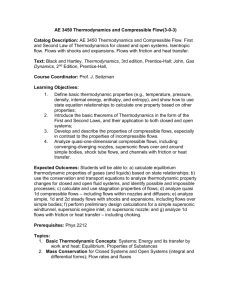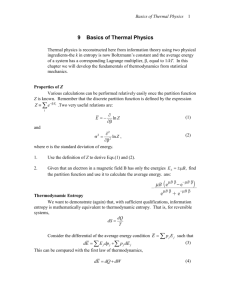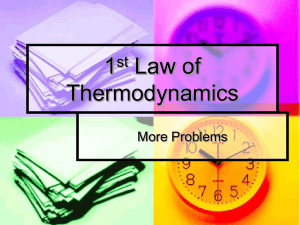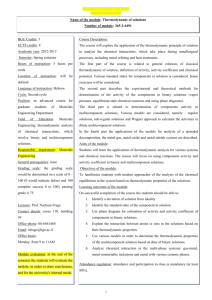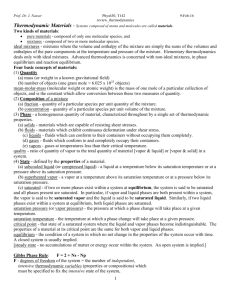Thermodynamic Processes and Cycles
advertisement
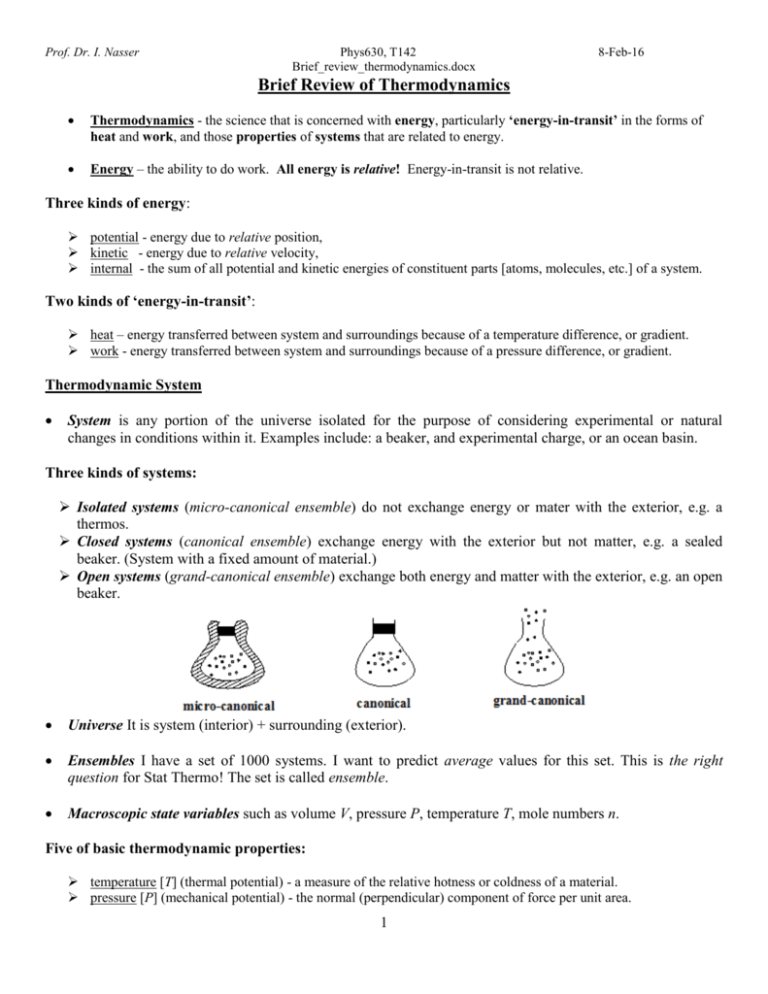
Prof. Dr. I. Nasser Phys630, T142 Brief_review_thermodynamics.docx 8-Feb-16 Brief Review of Thermodynamics Thermodynamics - the science that is concerned with energy, particularly ‘energy-in-transit’ in the forms of heat and work, and those properties of systems that are related to energy. Energy – the ability to do work. All energy is relative! Energy-in-transit is not relative. Three kinds of energy: potential - energy due to relative position, kinetic - energy due to relative velocity, internal - the sum of all potential and kinetic energies of constituent parts [atoms, molecules, etc.] of a system. Two kinds of ‘energy-in-transit’: heat – energy transferred between system and surroundings because of a temperature difference, or gradient. work - energy transferred between system and surroundings because of a pressure difference, or gradient. Thermodynamic System System is any portion of the universe isolated for the purpose of considering experimental or natural changes in conditions within it. Examples include: a beaker, and experimental charge, or an ocean basin. Three kinds of systems: Isolated systems (micro-canonical ensemble) do not exchange energy or mater with the exterior, e.g. a thermos. Closed systems (canonical ensemble) exchange energy with the exterior but not matter, e.g. a sealed beaker. (System with a fixed amount of material.) Open systems (grand-canonical ensemble) exchange both energy and matter with the exterior, e.g. an open beaker. Universe It is system (interior) + surrounding (exterior). Ensembles I have a set of 1000 systems. I want to predict average values for this set. This is the right question for Stat Thermo! The set is called ensemble. Macroscopic state variables such as volume V, pressure P, temperature T, mole numbers n. Five of basic thermodynamic properties: temperature [T] (thermal potential) - a measure of the relative hotness or coldness of a material. pressure [P] (mechanical potential) - the normal (perpendicular) component of force per unit area. 1 Prof. Dr. I. Nasser Phys630, T142 Brief_review_thermodynamics.docx 8-Feb-16 volume [V] (mechanical displacement) - the quantity of space possessed by a material. entropy [S] (thermal displacement) - the quantity of disorder possessed by a material. internal energy [U] - the energy of a material which is due to the kinetic and potential energies of its constituent parts (atoms and molecules, usually). Two secondary thermodynamic properties: enthalpy [H] - internal energy plus the pressure-volume product. heat capacity [ C P or CV ] (specific heat) - the amount of energy required to increase the temperature of one unit quantity of material by one degree, under specific conditions. dH dT dU CV dT (a) constant pressure C P (b) constant volume Unlike gases, liquids and solids are nearly incompressible, and it is almost impossible to change their temperature while holding their volumes constant. The specific heats of liquids and solids almost always imply their constant pressure heat capacity (usually on a unit mass basis), so that, in general, for liquids and solids we used C P . Thermodynamic Properties - any quantity (variables) that depends only on the state of a material and is independent of the process by which a material arrives at a given state. Two types of variables: Intensive variables: do not depend on the amount of substance present. Examples include: the temperature T, pressure P, density (mass/volume) , chemical potential of type i i , and the external magnetic field H . Extensive variables: depend on the amount of matter in the system (e.g. mass). Examples include: particle number of typ type i N i , the volume V, internal energy U, enthalpy H, entropy S, and heat capacity C, total magnetic moment M . Notes: 1- When we put two identical systems together, the intensive quantities, such as the temperature, would be unchanged but the extensive quantities, such as the entropy, would be doubled. This is possible only when the surface energy of the system is neglected. Such condition is justified since we are considering a macroscopic system which can be assumed arbitrarily large and the surface effect can be made arbitrarily small. 2- Any extensive variable can be converted to an intensive variable by dividing it by the moles or the mass. 3- The usual extensive variables become infinite in the thermodynamic limit. We therefore use densities: 2 Prof. Dr. I. Nasser Phys630, T142 Brief_review_thermodynamics.docx 8-Feb-16 Thermodynamic limit, i. e. in the limit where V , N at fixed intensive variables Reasons: 1- For finite systems the thermodynamic quantities are always analytic functions of their variables. In a finite system the partition function of any system is a finite sum of analytic functions of its parameters, and is therefore always analytic 2- Singular behavior as required for phase transitions does not occur. Because of the finite volume the correlation length is finite. Spontaneous symmetry breaking exists only in the thermodynamic limit. In finite systems the breaking is explicit by an external field or by the boundary conditions. In the thermodynamic limit the different ensembles are equivalent. In the thermodynamic limit there is no boundary (surface) dependence. 345- Equilibrium state is one in which the properties of the system are uniform throughout and do not change with time unless the system is acted upon by external influences (e.g. magnetic or electric fields). Equilibrium within a system is achieved when the system reaches its lowest energy state consistent with the imposed conditions. If temperature and pressure are specified, the equilibrium configuration possesses the lowest possible Gibbs Free energy (G). Stability is the condition of equilibrium (minimum G). A system is said to be in thermodynamic equilibrium if it attains: Thermal equilibrium (ΔT = 0). Mechanical equilibrium (ΔP = 0), which means that all forces of interaction between the system and surroundings are in equilibrium. Chemical equilibrium (Δ i = 0), i.e. no change in structure takes place. Non-Equilibrium characterizes a system in which gradients exist and whose properties vary with time (e.g. the atmosphere and the oceans) Equation of state is a functional relationship among the state variables for a system in equilibrium, e.g. PV nRT . State function depends only on the initial and final positions. For example: Energy, Entropy. Work and heat are not state functions because they are depending on their path. Exact differentials e.g. dV, dP, dT, and dU. Exact differentials may be integrated since we are only concerned with the initial and final states, not with the path taken as dW. Usually the state function is an exact differential. and dW Inexact differentials e.g. dQ , cannot integrated unless we know the path taken by the system in passing from state to another. Systems wall is the boundary between a system and its surroundings through which changes may be imposed. 3 Prof. Dr. I. Nasser Phys630, T142 Brief_review_thermodynamics.docx 8-Feb-16 Two kinds of separation walls: 1- Adiabatic wall is a boundary that permits no heat interaction between the system and its surroundings. 2- Diathermal wall is a boundary that freely allows heat to be exchanged. Thermodynamic Processes and Cycles Path is a series of states through which a system passes. A process any succession of events, i.e. a change of state expressed in terms of a path along the equation of state surface. A quasi-static process is a process in which, at each instant, the system is only departs infinitesimally from an equilibrium state. chemical process - a chemical or physical operation, or series of operations, which transforms raw materials into products. thermodynamic process - the path of succession of states through which the system passes in moving from an initial state to a final state. polytropic process - a thermodynamic process for which PV n constant . These processes are usually associated only to systems for which the ideal gas assumption holds. Four special polytropic processes: 1234- isobaric process done at constant pressure, (ΔP = 0). [n0] isothermal process done at constant temperature , (ΔT = 0). [ n 1 ] isentropic process done at constant entropy [ n CP / CV ] isochoric (isometric) - process done at constant volume, (ΔV = 0). [ n ] Two other important processes: 1- adiabatic - no heat transfer, (ΔQ = 0). 2- isenthalpic - constant enthalpy. This is the same as isothermal for an ideal gas system. A reversible process – an idealized process in which the deviation from thermodynamic equilibrium is infinitesimal at any particular instant during the process. All of the states through which a system passes during a reversible process may be considered to be equilibrium states. This is an idealized situation that would require infinite time and/or equipment size to be realized. The concept of a reversible process serves to set a maximum for the efficiency of a given process. Note that an isentropic process is an adiabatic-reversible process, so that real isentropic processes are not possible. Irreversible: if the process cannot be reversed (like most processes). Thermodynamic cycle: a process for which the final and initial states are the same. Four common ‘idealized’ thermodynamic cycles: 1234- Carnot cycle - isothermal and isentropic compressions followed by isothermal and isentropic expansions. Rankine cycle - isobaric and isentropic compressions followed by isobaric and isentropic expansions. Otto cycle - isentropic and isochoric compressions followed by isentropic and isochoric expansions. Diesel cycle - isentropic compression followed by isobaric, isentropic and isochoric expansions 4 Prof. Dr. I. Nasser Phys630, T142 Brief_review_thermodynamics.docx 8-Feb-16 Thermodynamic Laws A physical law is a simple statement of an observable physical phenomenon that has no underlying, more-basic reason for being except that the most accurate observations have always proved it to be true. Laws of Thermodynamics Zeroth: Two bodies in thermal equilibrium with a third body are in thermal equilibrium with each other. (This Law? simply states that ‘thermometers work’.) First law: has to do with conservation of energy; “The total energy of an isolated system must remain constant, although there may be changes from one form of energy to another”. If we designate the total or internal energy of an isolated or closed system as U, heat as Q and work as W, then the circular integral involving no change in net internal energy is: (1) dW 0 dQ where work and heat are not exact differentials because they depend on path and are not state functions. If the system is closed to the input of matter, but not of energy, then U dW (2) dU dQ CV T V Mechanical work is, of course only the product of force x distance and force is pressure P x surface area, so mechanical work is simply the product of pressure x surface area x distance, or PV. At constant pressure: (3) PdV dW Substituting in Eq. 2 yields the most common form of the first law of thermodynamics: PdV (4) dU dQ In other words, you can't win -- energy cannot be created, only converted from one form to another. A Simple Statement: Heat and work are both forms of energy in transit, and energy is always conserved. or A Classical Statement: During any cyclic process on a closed system the cyclic integral of heat is always equal to the cyclic integral of work. Enthalpy The enthalpy or heat content is defined as: H = U + PV (5) It's clear from this relationship that enthalpy is the sum of two energy terms. Differentiating (5) at constant pressure: dH = dU+PdV (6) PdV , we have and from (4) dU dQ dH = dQ (7) which shows that at constant pressure, the change in enthalpy is governed by the added work performed on the system. 5 Prof. Dr. I. Nasser Phys630, T142 Brief_review_thermodynamics.docx 8-Feb-16 Second law: There are several nearly equivalent statements of the second law but ultimately all boil down to statements about entropy. The extensive state function entropy is an increasing function of energy. Entropy obeys Clausius Inequality in the form Q dQ ds dS T T where the equality sign is for a reversible process. The success of second law of thermodynamics is of course in the introduction of free energies Simple Statement #1: Spontaneous fluxes always take place down their corresponding potential gradients. or Simple Statement #2: Heat and work are both forms of energy in transit, but they are not qualitatively equal forms of energy because work can always be converted entirely into heat, but heat can never be converted entirely into work. or Kelvin-Plank Statement: It is impossible to construct a device which operates in a cycle and produces no effect other than the raising of a weight and the exchange of heat with a single reservoir. or Clausius Statement: It is impossible to construct a device which operates in a cycle and produces no effect other than the transfer of heat from a cooler body to a hotter body. Albert Einstein considered the Second Law of Thermodynamics to be the only real physical law. Third law: in simple statement “Entropy of a perfectly crystalline substance is zero ate absolute zero”. 6 Prof. Dr. I. Nasser Phys630, T142 Brief_review_thermodynamics.docx 8-Feb-16 However, it is the third law that allows calculation of entropy T S (CP / T )dT 0 We can find temperature dependence of the specific heat in the form of a series in T in many handbooks and these expansions are widely used by Geologists, Metallurgists and Chemical Thermodynamics researchers in the evaluation of free energy. Nerst’s statement: All reactions in a pure liquid or solid in thermal equilibrium take place with no change of entropy in the neighborhood of absolute zero. lim (S1 S 2 ) 0 where the subscripts 1 and 2 refer to the initial and final states, respectively. Planck’s statement: The entropy of a true equilibrium state of a system at absolute zero is zero. It is applicable to all condensed phases, including solutions lim S 0 Unattainability statement: It is impossible to reduce the temperature of a system to absolute zero using a finite number of processes. Important notes: 1- As the entropy of a substance is a measure of randomness or disorder, So = 0 implies a highly order (maximum order) state of matter. 2- This law applies to perfect crystalline substance only. Unfortunately, perfect crystalline substances are difficult to identify. 3- A glass or amorphous substance is not completely ordered even at the absolute zero of temperature. Therefore, any disorder remaining at the absolute zero of temperature gives a finite value of So. Consequences of the third law: 1- For all known solids, the expansivity approaches zero as the temperature approaches absolute zero. lim 0 . 2- The slope of the boundary between two phases is zero at absolute zero. dP lim 0. dT 3- The heat capacities approach zero as the temperature approaches absolute zero. lim CV 0, lim C P 0 . Other Laws of Importance in Thermodynamics Conservation of Matter: Matter can be neither created nor destroyed but only changed from one form to another. Note that Albert Einstein showed that matter could be ‘destroyed’ by converting it into energy. Joule's Law: The internal energy of an ideal gas is a function of temperature only. Avagadro's Law: Equal volumes of different ideal gases at the same temperature and pressure contain the same number of molecules. 7 Prof. Dr. I. Nasser Phys630, T142 Brief_review_thermodynamics.docx 8-Feb-16 Thermodynamic potentials (summary) Thermodynamic potential Independent variables Internal energy U S,V dU = TdS - PdV Enthalpy S,P dH = TdS + VdP U U T , P S V V S H H T ,V S P P S T,V dF = – SdT – PdV F F S , P T V V T T,P dG = – SdT + VdP G G S ,V T P P T H U PV Helmholtz function F U TS Reciprocity relations Gibbs function G U TS PV H TS F PV First Td equation P Tds CV dT T dV T V Second Td equation V Tds CPdT T T Third Td equation T T Tds CV dP CP P V V S ,V are constant. S , P are constant. T ,V are constant. T , P are constant. Tds CV dT T dP P 2U T P V S S V V S 2H T v P S S P PS 2F S P V T T V V T 2G S V P T T P PT dV Tds CP T dP dV P dS dV 0 dS dP 0 dT dV 0 dT dP 0 dU 0 dH 0 dF 0 dG 0 dS 0 dQ dU PdV 0 U is the internal energy (SI unit: joule) p is pressure (SI unit: pascal) V is volume (SI unit: m3) T is the temperature (SI unit: kelvin) S is the entropy (SI unit: joule per kelvin) H is the enthalpy (SI unit: joule) Adiabatic Maxwell relations 8 Minimum U Minimum H Minimum F Minimum G Maximum S Prof. Dr. I. Nasser Phys630, T142 Brief_review_thermodynamics.docx Theromdynamic functions Notation Internal energy Heat function (enthalpy) Helmholtz free energy U is a thermodynamic potential that measures the “useful” work obtainable from a closed thermodynamic system at a constant temperature. Gibbs free energy 8-Feb-16 H F Independent variables S ,V , N S , P, N T ,V , N TdS PdV dN TdS VdP dN SdT PdV dN G T , P, N SdT VdP dN T ,V , SdT PdV Nd The energy associated with a chemical reaction that can be used to do work. Landau free energy 1 V V T P 1 V Differential V P T PV NRT R CP CV dQ dU dW dQ Tds U CP T P U CV T V P T V CV S T T V X Y Z 1 Y Z Z X X Y Q mc T n(number of mole) P M sample mN A T ( R) T ( F ) 459.67 1 Liter = 10-3 m3 W t m(mass of atom) W Qh Qc Qh Qh PV constant, PV nRT M sample NA 9 T ( F ) T 32 5 1 calorie = 4.186 Joule 9 K 1 Tc Th 3 KT 2 (carnot ) R = 8.31 J/mol K 1Bar 105 pascal 1Atm 1.01105 pascal k = 1.38 x 10-23 J/K NA = 6.02 x 1023 molecules/mole



